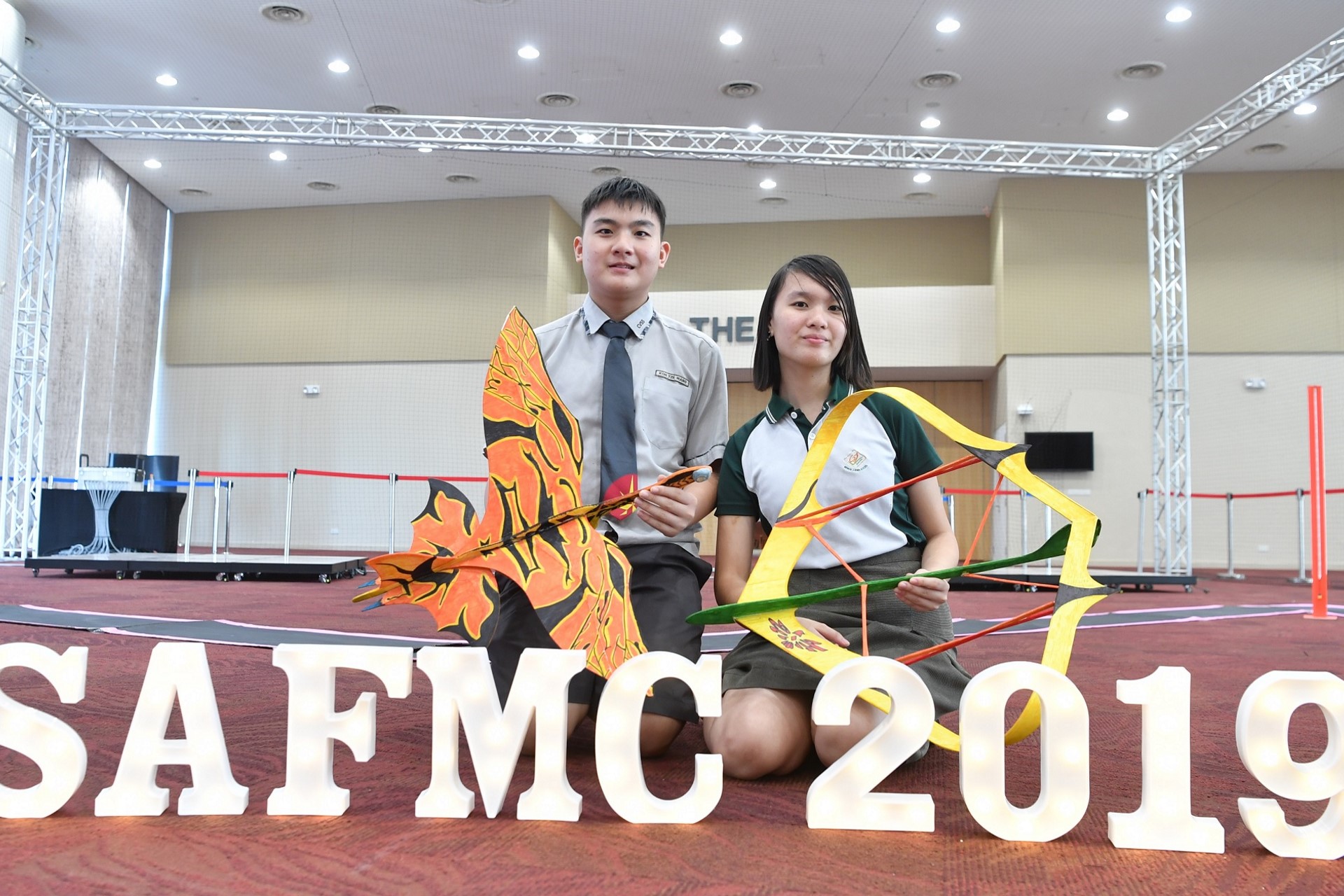TWO TO FLY: SIBLINGS WIN AMAZING FLYING MACHINE PRIZES
// Report by Benita Teo // Photos by Chai Sian Liang
When siblings Koh Niann Tsyr, 16, and Koh Tze Wang, 14, say they are "flying together", they don't mean that they are going on a family holiday – they are actually building and operating their own flying machines!
Growing up in a house filled with model aeroplanes belonging to their father who is an aviation enthusiast, Tze Wang developed a love for aeronautics from a young age.
He joined the Singapore Youth Flying Club when he entered Compassvale Secondary School last year. He also began participating in the Singapore Amazing Flying Machine Competition (SAFMC), and won several prizes in aeronautics-related competitions.
Seeing her brother grow his hobby into a medal-winning endeavour, Niann Tsyr, a Secondary Four student in Greendale Secondary School, started to find out more, and soon grew to love flight dynamics and aeronautics as well.
With his encouragement, she decided to join him at the SAFMC this year, with each representing their respective schools.
The pair's respective teams did well at this year's SAFMC. Tze Wang, who participated in four categories, took home as many medals. His team also earned the honour for being the only secondary school team in Category D1 (Semi-Autonomous), where they placed third. The category is usually sees participation from polytechnics and universities.
Niann Tsyr's team was ranked first in the "Most Creative Award" for Category B (Unpowered Gliders), ahead of her brother's team.
"(Participating in the SAFMC) helps me expand my knowledge of aeronautics. I also learn a lot about teamwork and resilience, especially when taking part in so many different categories," he said.
Despite being "rivals" in the competition, there was no bitter rivalry between the two, said Tze Wang. "We got to learn together and we encouraged each other. We shared tips as well. It helps to have someone to share tips with," said the Secondary Two student.
Their cooperation certainly paid off and the siblings have set their sights higher and hope to fly an actual plane together someday.
On 23 March, Niann Tsyr and Tze Wang's parents looked on proudly as they received their medals at the prize presentation ceremony held at ITE College Central.
Into its 11th edition, this year's competition attracted more than 490 teams with 1,788 participants from Singapore and overseas.
In his speech, Senior Minister of State for Defence Heng Chee How reminded the participants to always stay curious and find creative solutions to everyday problems.
"It is this curiosity that has paved the way for fields like drone technology to reach new heights (and) underpins some of the most innovative contributions to society today… Ultimately, it is this curiosity that leads to innovation.
"Innovation is something which Singapore, and indeed, countries around the world, relies greatly on in order to move themselves forward," he said.
A new category, FPV (First-Person View) Flight (Micro), was introduced this year to reflect the growing popularity of FPV technology in drone flying. The top prize for this new category went to a team from Saint Andrew's Secondary School.
Team leader Wong Jin Rong said that the experience gave the team a good lesson on the different types of drones and how to select the right one to suit certain needs: "For example, (while our) competitors used 120mm drones, which are much more powerful, (our) small and light 65mm drones are lighter and more agile - it's able to do tighter turns and (thus) reduce lap times significantly."
The 14-year-old student added: "Therefore, in competition you don't just think about flying and winning the race but you also need to be strategic."
For the team from Singapore Polytechnic, SP_AERO_YPMA, it was their experience that proved useful.
Not satisfied with their silver medal last year, final-year Aerospace Electronics students Jerriel Wai, Matthew Tan and David Tan, all 20, returned for another fight and finally took home the Category D1 champion's prize. In this category, participants have to design and build a semi-autonomous small air platform to perform a range of tasks in an indoor open course.
The competition was no walk in the park, said team leader Jerriel. The team had to build a drone that could pick up a small payload and place it accurately on the allocated landing square.
"The electromagnet needed to be perfectly aligned to work, so we had to measure the dimensions very precisely. We had to practice a lot – it takes a lot of skill to land just right and pick up the payload," he said.
"It's a great improvement from (our results) last year. (We've shown that) with perseverance and confidence, we can win the championship award" he added.
As for Nanyang Polytechnic second-year student and first-time participant Santhosh Kumar, being different proved to be an important asset in the competition. Unlike his teammates Adrian Wong and Low Jia Hwee, who are both students of Aerospace Systems and Management, he studies Electrical Engineering with Eco Design.
Thanks to his unique skills, his team won the 5th place medal in Category D1.
"(As an electrical engineer) I know about the assembling of the parts, so I can help with stringing the parts together and buying the necessary parts," said the 19-year-old.
"(Conversely,) they taught me more about drones so that I have a more comprehensive understanding and we can make our drones better," he added.
Organised by DSO National Laboratories, the annual competition pits the skills of young scientists and engineers as they compete to design and build the most creative flying machine. It is a platform for students and youth to hone their skills in flight science and kick-start their careers in the field.










